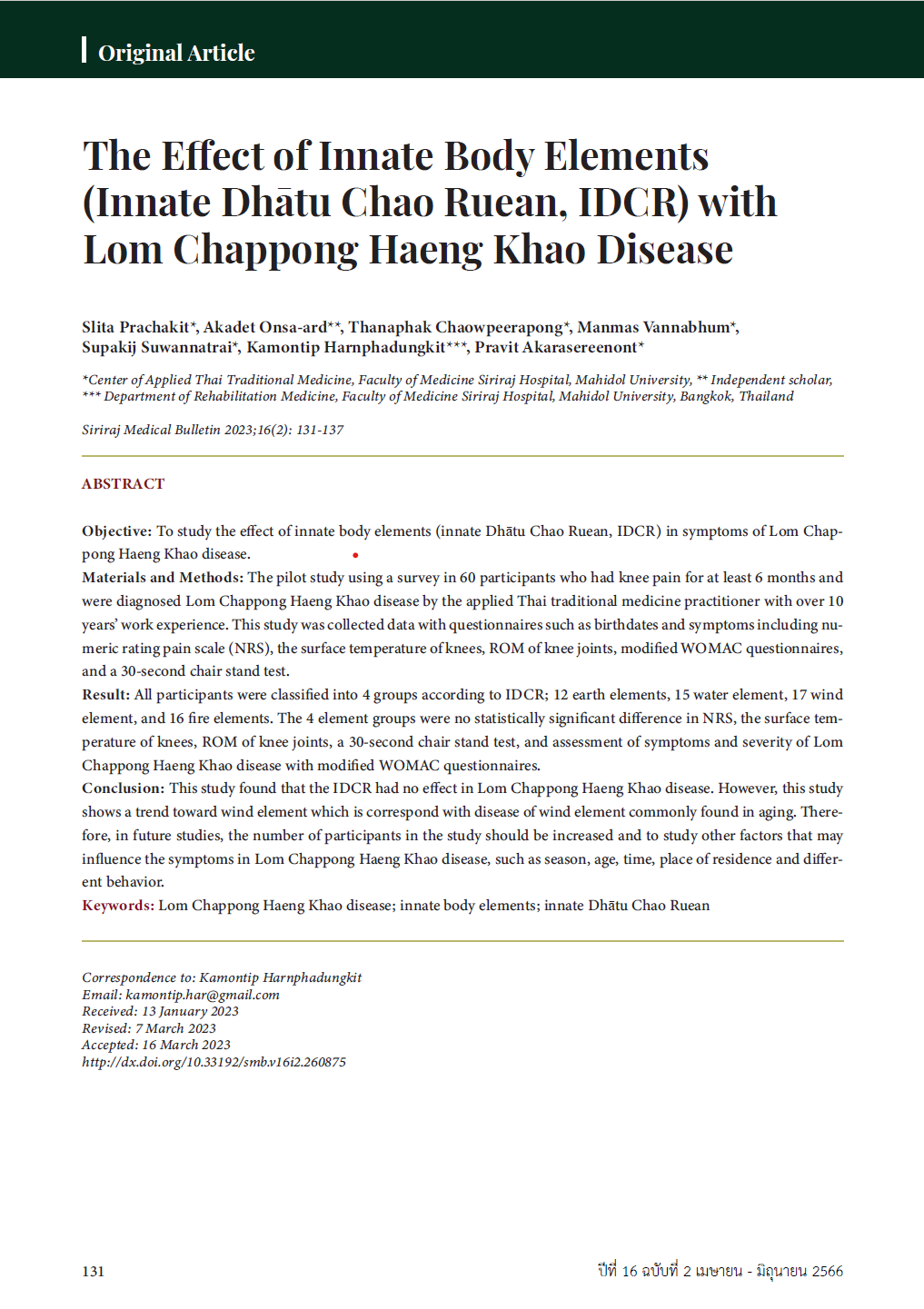The Effect of Innate Body Elements (Innate Dhātu Chao Ruean, IDCR) with Lom Chappong Haeng Khao Disease
Main Article Content
Abstract
Objective: To study the effect of innate body elements (innate Dhātu Chao Ruean, IDCR) in symptoms of Lom Chappong Haeng Khao disease.
Materials and Methods: The pilot study using a survey in 60 participants who had knee pain for at least 6 months and were diagnosed Lom Chappong Haeng Khao disease by the applied Thai traditional medicine practitioner with over 10 years’ work experience. This study was collected data with questionnaires such as birthdates and symptoms including numeric rating pain scale (NRS), the surface temperature of knees, ROM of knee joints, modified WOMAC questionnaires, and a 30-second chair stand test.
Result: All participants were classified into 4 groups according to IDCR; 12 earth elements, 15 water element, 17 wind element, and 16 fire elements. The 4 element groups were no statistically significant difference in NRS, the surface temperature of knees, ROM of knee joints, a 30-second chair stand test, and assessment of symptoms and severity of Lom Chappong Haeng Khao disease with modified WOMAC questionnaires.
Conclusion: This study found that the IDCR had no effect in Lom Chappong Haeng Khao disease. However, this study shows a trend toward wind element which is correspond with disease of wind element commonly found in aging. Therefore, in future studies, the number of participants in the study should be increased and to study other factors that may influence the symptoms in Lom Chappong Haeng Khao disease, such as season, age, time, place of residence and different behavior.
Article Details

This work is licensed under a Creative Commons Attribution-NonCommercial-NoDerivatives 4.0 International License.
References
มูลนิธิฟื้นฟูส่งเสริมการแพทย์ไทยเดิมฯ และโรงเรียนอายุรเวทธำรง. ตำราการแพทย์แผนไทยเดิม (แพทยศาสตร์สงเคราะห์ฉบับอนุรักษ์) เล่มที่ 1. กรุงเทพมหานคร. ศุภวนิชการพิมพ์; 2550.
ทวี เลาหพันธ์, เอื้อพงศ์ จตุรธำรง, ชัชภาม จันทบุตร, เทียมจิต ทองลือ, ประมวล คำแก้ว, ประสพพร พันธ์เพ็ง, และคณะ. การแพทย์แผนไทย ในคณะแพทยศาสตร์ศิริราชพยาบาล. กรุงเทพมหานคร: ศุภวนิชการพิมพ์; 2552.
พิศณุประศาสตร์เวช, พระยาตำราเวชศึกษาแพทย์ศาสตร์สังเขป. กรุงเทพมหานคร: โรงพิมพ์ไทย. ร.ศ.127.
มูลนิธิฟื้นฟูส่งเสริมการแพทย์ไทยเดิมฯ โรงเรียนอายุรเวท. หัตถเวชกรรมแผนไทย (นวดแบบราชสำนัก). กรุงเทพฯ: บริษัท พิฆเณศ พริ้น ติ้งเซ็นเตอร์, 2548.
ศุภกิจ สุวรรณไตรย์, ธเนศพล พันธ์เพ็ง, นันทิพัฒน์ คำแก้ว, ปิยาอร สีรูปหมอก, พัชรพล อุดมเกียรติ, อารีศักดิ์ โชติ วิจิตร, และคณะ. การเปรียบเทียบการวินิจฉัยโรคข้อเข่าเสื่อมทางแพทย์แผนตะวันตกกับโรคลมจับโปงแห้งเข่าทาง แพทย์แผนไทย. เวชบันทึกศิริราช 2561;11(2),88-95.
สถานการแพทย์แผนไทยประยุกต์ คณะแพทยศาสตร์ศิริราชพยาบาล มหาวิทยาลัยมหิดล. การแพทย์แผนไทยประยุกต์กับการพัฒนาการแพทย์แผนไทยให้ยั่งยืน ๒๕๕๕. กรุงเทพมหานคร: : ศุภวนิชการพิมพ์; 2555.
ทัพพ์เทพ ทิพยเจริญธัม, ผ่องพิมล ดาศรี, ศุภกิจ สุวรรณไตรย์, สุวีรวรรณ ลิ้มสุวรรณ, เพ็ญจันทร์ ประดับมุข เชอร์เรอร์, ประวิทย์ อัครเสรีนนท์. การประเมินความสัมพันธ์ระหว่างธาตุเจ้าเรือนกำเนิดกับลักษณะของผู้ป่วยโรคความดันโลหิตสูง ในคลินิกอายุรเวท แพทย์แผนไทยประยุกต์ โรงพยาบาลศิริราช. เวชบันทึกศิริราช 2561;3:158-166.
Dobson F, Hinman RS, Roos EM, Abbott JH, Stratford P, Davis AM, et al. OARSI recommended performance-based tests to assess physical function in people diagnosed with hip or knee osteoarthritis. Osteoarthritis Cartilage. 2013;21(8):1042-52.






